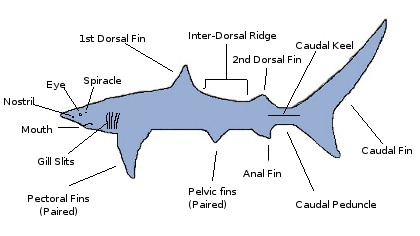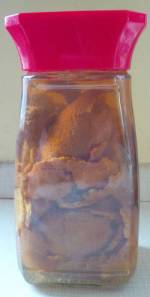Shark Anatomy
A Quick Guide to a Fascinating Body
On the surface of it shark anatomy looks pretty straight forward, but as you delve a bit deeper you discover all kinds of awesome things.
Most sharks have a roughly spindle-shaped body which is designed to move easily through the water.
They have five sets of fins, each with a specific purpose, and they breathe through their gills.

External Shark Anatomy
Let's have a closer look at what makes shark anatomy so amazing.
- Caudal Keel - The caudal keel is present in some species of shark and helps to strengthen the caudal peduncle, or tail base, as well as streamlining the shark for easier movement through the water.
- Eyes - Like the human eye, a shark's eye has a retina, a cornea, an iris and a lens. They're also able to control the size of the pupil depending on the amount of light available. Some sharks have a nictitating membrane, or third eyelid to protect the eye.
- Fins - Sharks have five sets of fins. The pelvic, anal and dorsal fins are used to stabilise them in the water while the caudal fin propels them forward and the pectorals give them lift, and allow them to change direction.
- Gills - Sharks have 5 to 7 pairs of gills situated on the sides of the head. Oxygenated water must constantly move over them to allow the filaments to pass the oxygen from the water and into the shark's blood.
- Skin - Shark skin has a unique feature known as placoid scales or dermal denticles. They help to guide the flow of water over the body so that shark can move smoothly and with less resistance.
Dermal denticles are what gives shark skin its rough feel, and they're the reason it used to be used as sandpaper.
- Spiracle - The spiracle is an opening behind the eye of some species of shark. It helps to direct oxygen to the eye and the brain.
In benthic, or bottom-dwelling sharks, the spiracle is larger and more developed. This is particularly so in rays where it helps pump water over the gill so they can breathe when they bury themselves in the sand.
- Teeth - Shark's teeth are not embedded in the jaw, but are attached to a sheet of cartilage known as a tooth bed. As the shark grows the old teeth are shed, and the new tooth behind it on the tooth bed moves forward to replace the lost one.
Return to World of Sharks from Shark Anatomy
Recent Articles
-
Thresher Sharks
Aug 27, 14 10:51 AM
Thresher sharks are unmistakable with that huge upper lobe on the caudal fin. Let's find out more about them. -
Sharkwater
Aug 14, 14 12:42 PM
Sharkwater is a documentary by Rob Stewart highlighting the plight of the sharks in our oceans. -
Natural Cleaners
Aug 13, 14 08:57 AM
Natural cleaners and homemade skincare products are not only better for the environment, they're better for you and your family.
